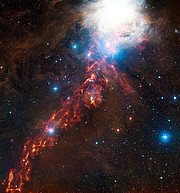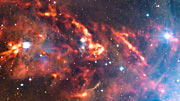Comunicato Stampa
Un nastro di fuoco celato in Orione
15 Maggio 2013

Questa nuova, straordinaria immagine di nubi cosmiche nella costellazione di Orione rivela quello che sembra un nastro infuocato in cielo. Il bagliore arancione è dovuto alla debole luce dei grani di polvere interestellare fredda, a lunghezze d'onda troppo lunghe per essere viste dall'occhio umano. È stato osservato dal telescopio APEX (Atacama Pathfinder Experiment) gestito dall'ESO in Cile.
Le nubi di gas e polvere interstellare sono la materia prima da cui si formano le stelle. Ma questi minuscoli grani di polvere bloccano la nostra visuale su ciò che si trova all'interno e dietro alle nubi - almeno alle lunghezze d'onda del visibile - rendendo difficile osservare il processo di formazione stellare.
Questo è il motivo per cui gli astronomi devono usare strumenti in grado di vedere luce di altre lunghezze d'onda. Nella banda submillimetrica i grani di polvere non bloccano la luce ma risplendono a causa della loro temperatura di qualche decina di gradi sopra lo zero assoluto [1]. Il telescopio APEX, con la sua camera LABOCA per lunghezze d'onda submillimetriche, e l'altitudine di 5000 metri sul livello del mare nella piana di Chajnantor nelle Ande cilene, è lo strumento ideale per questo tipo di osservazioni.
Questa nuova, spettacolare fotografia mostra parte di un complesso più grande noto come Nube Molecolare di Orione, nella costellazione omonima. Un crogiuolo di nebulose brillanti, di stelle giovani e calde e di nubi molecolari fredde: questa regione si estende per centinaia di anni luce e si trova a circa 1350 anni luce da noi. Il bagliore prodotto dalle nubi di polvere fredda a lunghezze d'onda submillimetriche è di color arancio in questa immagine, ed è sovrapposto a una fotografia presa nella più familliare luce visibile.
La grande nube brillante in alto a destra nell'immagine è la ben nota Nebulosa di Orione, chiamata anche Messier 42. È facilmente visibile a occhio nudo come la "stella" leggermente sfuocata nel centro della spada di Orione. La Nebulosa di Orione è la zona più brillante di un'enorme incubatrice stellare in cui nascono nuove stelle ed è il sito di massiccia formazione di stelle più vicino alla Terra.
Le nubi di polvere formano bellissimi filamenti, piani e bolle come risultato di processi come il collasso gravitazionale e gli effetti dei venti stellari. I venti stellari sono flussi di gas espluso dall'atmosfera delle stelle, sufficientemente potenti da modellare le nubi circostanti nelle forme contorte che vediamo qui.
Gli astronomi hanno usato questi e altri dati di APEX, insieme alle immagini dell'Osservatorio Spaziale Herschel dell'ESA, per cercare proto-stelle - una fase iniziale nel processo di formazione stellare - nella regione di Orione. Sono stati finora in grado di identificare 15 oggetti che appaiono molto più brillanti a lunghezze d'onda lunghe che a quelle più corte. Questi rari oggetti appena scoperti sono probabilmente le più giovani proto-stelle mai trovate e aiutano gli astronomi ad avvicinarsi a scoprire il momento in cui una stella inizia a formarsi.
Note
[1] Gli oggetti più caldi emettono la maggior parte della radiazione a lunghezze d'onda corte, mentre quelli più freddi a lunghezze d'onda maggiori. Di conseguenza stelle molto calde (con temperature superficiali di 20 000 gradi Kelvin) appaiono blu, mentre quelle più fredde (con temperature in superficie di circa 3000 gradi Kelvin) appaiono rosse. Una nube di polvere alla temperatura di dieci gradi Kelvin produce emissione con un picco a lunghezze d'onda ancora maggiori - intorno a 0,3 millimetri - nella zona dello spettro a cui è più sensibile APEX.
Ulteriori Informazioni
La ricerca di proto-stelle in questa regione è descritta nell'articolo “A Herschel and APEX Census of the Reddest Sources in Orion: Searching for the Youngest Protostars” di A. Stutz et al., per la rivista Astrophysical Journal.
Le osservazioni con APEX usate per questa immagine sono state condotte da Thomas Stanke (ESO), Tom Megeath (University of Toledo, USA), e Amelia Stutz (Max Planck Institute for Astronomy, Heidelberg, Germania). APEX è una collaborazione tra il Max Planck Institute for Radio Astronomy (MPIfR), l'Onsala Space Observatory (OSO) e l'ESO. Le operazioni di APEX a Chajnantor sono affidate all'ESO.
L'ESO (European Southern Observatory, o Osservatorio Australe Europeo) è la principale organizzazione intergovernativa di Astronomia in Europa e l'osservatorio astronomico più produttivo al mondo. È sostenuto da 15 paesi: Austria, Belgio, Brasile, Danimarca, Finlandia, Francia, Germania, Gran Bretagna, Italia, Olanda, Portogallo, Repubblica Ceca, Spagna, Svezia, e Svizzera. L'ESO svolge un ambizioso programma che si concentra sulla progettazione, costruzione e gestione di potenti strumenti astronomici da terra che consentano agli astronomi di realizzare importanti scoperte scientifiche. L'ESO ha anche un ruolo di punta nel promuovere e organizzare la cooperazione nella ricerca astronomica. L'ESO gestisce tre siti osservativi unici al mondo in Cile: La Silla, Paranal e Chajnantor. Sul Paranal, l'ESO gestisce il Very Large Telescope, osservatorio astronomico d'avanguardia nella banda visibile e due telescopi per survey. VISTA, il più grande telescopio per survey al mondo, lavora nella banda infrarossa mentre il VST (VLT Survey Telescope) è il più grande telescopio progettato appositamente per produrre survey del cielo in luce visibile. L'ESO è il partner europeo di un telescopio astronomico di concetto rivoluzionario, ALMA, il più grande progetto astronomico esistente. L'ESO al momento sta progettando l'European Extremely Large Telescope o E-ELT (significa Telescopio Europeo Estremamente Grande), un telescopio da 39 metri che opera nell'ottico e infrarosso vicino e che diventerà "il più grande occhio del mondo rivolto al cielo".
La traduzione dall'inglese dei comunicati stampa dell'ESO è un servizio dalla Rete di Divulgazione Scientifica dell'ESO (ESON: ESO Science Outreach Network) composta da ricercatori e divulgatori scientifici da tutti gli Stati Membri dell'ESO e altri paesi. ll nodo italiano della rete ESON è gestito da Anna Wolter.
Links
- Comunicati stampa collegati:
- Articolo scientifico
- Fotografie di APEX
- Immagini ottenute con APEX
Contatti
Amelia Stutz
Max Planck Institute for Astronomy
Heidelberg, Germany
Tel.: +49 6221 528 412
E-mail: stutz@mpia.de
Thomas Stanke
ESO
Garching bei München, Germany
Tel.: +49 89 3200 6116
E-mail: tstanke@eso.org
Richard Hook
ESO Public Information Officer
Garching bei München, Germany
Tel.: +49 89 3200 6655
Cell.: +49 151 1537 3591
E-mail: rhook@eso.org
Joerg Gasser (press contact Svizzera)
Rete di divulgazione scientifica dell'ESO
E-mail: eson-switzerland@eso.org
Sul Comunicato Stampa
| Comunicato Stampa N": | eso1321it-ch |
| Nome: | Orion Molecular Cloud |
| Tipo: | Milky Way : Nebula : Appearance : Dark |
| Facility: | Atacama Pathfinder Experiment |
| Instruments: | LABOCA |
| Science data: | 2013ApJ...767...36S |
Our use of Cookies
We use cookies that are essential for accessing our websites and using our services. We also use cookies to analyse, measure and improve our websites’ performance, to enable content sharing via social media and to display media content hosted on third-party platforms.
ESO Cookies Policy
The European Organisation for Astronomical Research in the Southern Hemisphere (ESO) is the pre-eminent intergovernmental science and technology organisation in astronomy. It carries out an ambitious programme focused on the design, construction and operation of powerful ground-based observing facilities for astronomy.
This Cookies Policy is intended to provide clarity by outlining the cookies used on the ESO public websites, their functions, the options you have for controlling them, and the ways you can contact us for additional details.
What are cookies?
Cookies are small pieces of data stored on your device by websites you visit. They serve various purposes, such as remembering login credentials and preferences and enhance your browsing experience.
Categories of cookies we use
Essential cookies (always active): These cookies are strictly necessary for the proper functioning of our website. Without these cookies, the website cannot operate correctly, and certain services, such as logging in or accessing secure areas, may not be available; because they are essential for the website’s operation, they cannot be disabled.
Functional Cookies: These cookies enhance your browsing experience by enabling additional features and personalization, such as remembering your preferences and settings. While not strictly necessary for the website to function, they improve usability and convenience; these cookies are only placed if you provide your consent.
Analytics cookies: These cookies collect information about how visitors interact with our website, such as which pages are visited most often and how users navigate the site. This data helps us improve website performance, optimize content, and enhance the user experience; these cookies are only placed if you provide your consent. We use the following analytics cookies.
Matomo Cookies:
This website uses Matomo (formerly Piwik), an open source software which enables the statistical analysis of website visits. Matomo uses cookies (text files) which are saved on your computer and which allow us to analyze how you use our website. The website user information generated by the cookies will only be saved on the servers of our IT Department. We use this information to analyze www.eso.org visits and to prepare reports on website activities. These data will not be disclosed to third parties.
On behalf of ESO, Matomo will use this information for the purpose of evaluating your use of the website, compiling reports on website activity and providing other services relating to website activity and internet usage.
Matomo cookies settings:
Additional Third-party cookies on ESO websites: some of our pages display content from external providers, e.g. YouTube.
Such third-party services are outside of ESO control and may, at any time, change their terms of service, use of cookies, etc.
YouTube: Some videos on the ESO website are embedded from ESO’s official YouTube channel. We have enabled YouTube’s privacy-enhanced mode, meaning that no cookies are set unless the user actively clicks on the video to play it. Additionally, in this mode, YouTube does not store any personally identifiable cookie data for embedded video playbacks. For more details, please refer to YouTube’s embedding videos information page.
Cookies can also be classified based on the following elements.
Regarding the domain, there are:
- First-party cookies, set by the website you are currently visiting. They are stored by the same domain that you are browsing and are used to enhance your experience on that site;
- Third-party cookies, set by a domain other than the one you are currently visiting.
As for their duration, cookies can be:
- Browser-session cookies, which are deleted when the user closes the browser;
- Stored cookies, which stay on the user's device for a predetermined period of time.
How to manage cookies
Cookie settings: You can modify your cookie choices for the ESO webpages at any time by clicking on the link Cookie settings at the bottom of any page.
In your browser: If you wish to delete cookies or instruct your browser to delete or block cookies by default, please visit the help pages of your browser:
Please be aware that if you delete or decline cookies, certain functionalities of our website may be not be available and your browsing experience may be affected.
You can set most browsers to prevent any cookies being placed on your device, but you may then have to manually adjust some preferences every time you visit a site/page. And some services and functionalities may not work properly at all (e.g. profile logging-in, shop check out).
Updates to the ESO Cookies Policy
The ESO Cookies Policy may be subject to future updates, which will be made available on this page.
Additional information
For any queries related to cookies, please contact: pdprATesoDOTorg.
As ESO public webpages are managed by our Department of Communication, your questions will be dealt with the support of the said Department.





